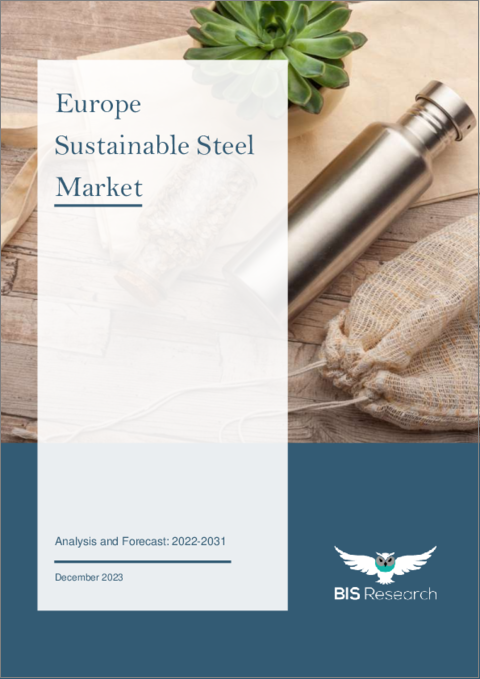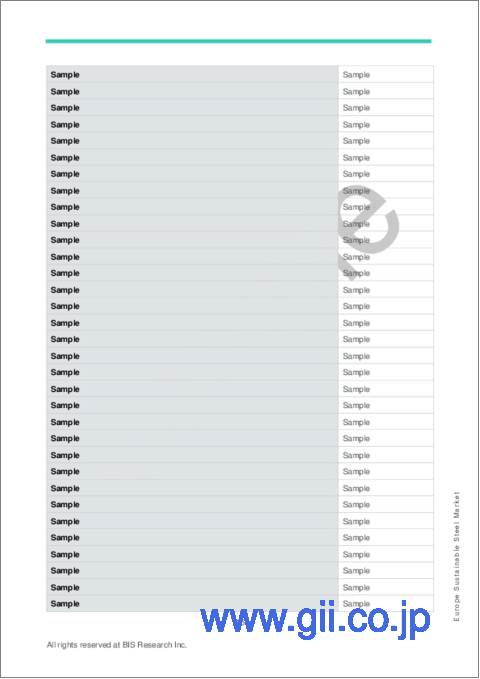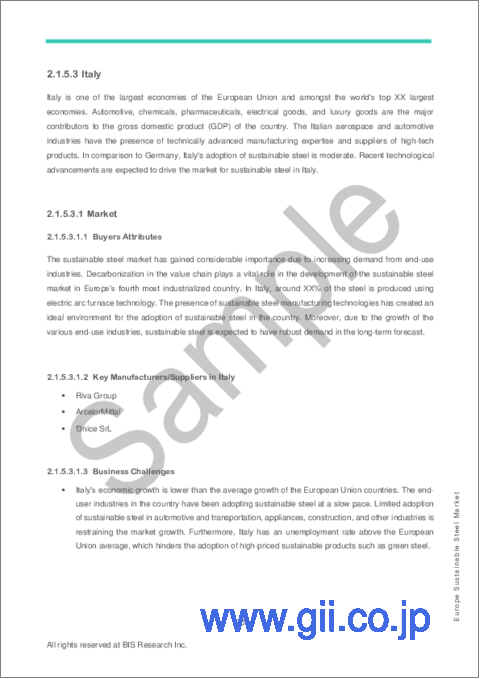|
|
市場調査レポート
商品コード
1396605
欧州のサステナブルスチール市場の分析・予測:2022-2031年Europe Sustainable Steel Market - Analysis and Forecast, 2022-2031 |
||||||
カスタマイズ可能
|
|||||||
| 欧州のサステナブルスチール市場の分析・予測:2022-2031年 |
|
出版日: 2023年12月15日
発行: BIS Research
ページ情報: 英文 102 Pages
納期: 1~5営業日
|
- 全表示
- 概要
- 図表
- 目次
英国を除く欧州のサステナブルスチールの市場規模は、2022年の860億米ドルから、予測期間中は7.57%のCAGRで推移し、2031年には1,659億米ドルの規模に成長すると予測されています。
欧州のサステナブルスチール産業の成長は、厳格な政府規制、カーボンニュートラル目標、再生鋼材の使用によるエネルギー効率とコスト効率への要望が原動力になると予想されています。また、エネルギーや原材料の不足だけでなく、鉄鋼需要の増加による市場の拡大も予想されています。一方で、リサイクル鋼に不純物が混入する可能性のある不完全な分離や複雑な製品設計、高いインフラとグリーン水素コストなどの障壁により、生産コストが高くなり、市場の成長を阻害する可能性があります。
| 主要市場統計 | |
|---|---|
| 予測期間 | 2022-2031年 |
| 2022年評価 | 860億米ドル |
| 2031年予測 | 1,659億米ドル |
| CAGR | 7.57% |
カーボンニュートラル目標、厳しい政府規制、手頃な価格でエネルギー効率の高いソリューションへのニーズの高まりなどの要因が欧州のサステナブルスチール市場の大幅な発展を促しています。この分野では、再生鋼の採用に焦点を当て、原材料とエネルギー資源の不足を克服したいと考えています。しかし、再生鋼材に含まれる汚染物質や、インフラコストとグリーン水素の高コストに起因するグリーン鋼材の生産コストの高さといった問題もあります。このような障害にもかかわらず、同地域が再生鋼とグリーンスチールソリューションの利点を受け入れ、持続可能性へのコミットメントを維持する中で、この業界は成長すると予想されています。
当レポートでは、欧州のサステナブルスチールの市場を調査し、市場の背景・概要、市場成長への各種影響因子の分析、市場規模の推移・予測、各種区分・主要国別の詳細分析、競合情勢、主要企業の分析などをまとめています。
市場の分類:
セグメンテーション1:エンドユーザー別
- 輸送
- 建築・建設
- 家具・家電
- 包装
- その他
セグメンテーション2:技術別
- 電気アーク炉 (EAF)
- 高炉-塩基性酸素炉 (BF-BOF)
- その他
セグメンテーション3:地域別
- 欧州:ドイツ・フランス・イタリア・スペイン・その他
目次
エグゼクティブサマリー
調査範囲
第1章 市場
- 業界の展望
- 動向:現在と未来
- サプライチェーン分析
- COVID-19によるサステナブルスチール市場への影響
- ロシア・ウクライナ戦争がサステナブルスチール市場に与える影響
- エコシステム/進行中のプログラム
- 事業力学
- 事業促進要因
- 事業上の課題
- 事業戦略
- 経営戦略
- 事業機会
- スタートアップの情勢
- 特許分析
- 世界および地域レベル:平均価格分析
- グリーンスチールのプロジェクトと開発
第2章 地域
- 欧州
- 市場
- 用途
- 製品
- 欧州のサステナブルスチール市場 (国別)
- 欧州 (国別)
- 英国
- 市場
- 用途
- 製品
第3章 市場:競合ベンチマーキング・企業プロファイル
- 競合ベンチマーキング
- 企業プロファイル
- ArcelorMittal
- LIBERTY Steel Group
- Lech Stahlwerke GmbH
- Celsa Group
- H2. Green Steel
第4章 調査手法
List of Figures
- Figure 1: Sustainable Steel Market, $Billion, 2021-2031
- Figure 2: Sustainable Steel Market (by End-Use Application), $Billion, 2021 and 2031
- Figure 3: Sustainable Steel Market (by Product Type), $Billion, 2021 and 2031
- Figure 4: Sustainable Steel Market (by Technology), $Billion, 2021 and 2031
- Figure 5: Sustainable Steel Market (by Region), $Billion, 2021 and 2031
- Figure 6: Supply Chain Analysis of the Sustainable Steel Market
- Figure 7: Patent Analysis (by Year), January 2019-November 2022
- Figure 8: Patent Analysis (by Status), January 2019-November 2022
- Figure 9: Patents Filed by Leading Countries, January 2019-November 2022
- Figure 10: Patents Granted to Leading Countries, January 2019-November 2022
- Figure 11: Research Methodology
- Figure 12: Top-Down and Bottom-Up Approach
- Figure 13: Influencing Factors of the Sustainable Steel Market
- Figure 14: Assumptions and Limitations
List of Tables
- Table 1: Sustainable Steel Market Snapshot, $Billion, 2021 and 2031
- Table 2: Key Market Developments
- Table 3: Key Product Developments (2019-2021)
- Table 4: Key Partnerships, Acquisitions, Collaborations, and Joint Ventures
- Table 5: Sustainable Steel Market, Average Pricing Analysis, $/Ton, 2021-2031
- Table 6: Sustainable Steel Market (by Region), Average Pricing Analysis, $/Ton, 2021-2031
- Table 7: Sustainable Steel Market (by Product Type), Average Pricing Analysis, $/Ton, 2021-2031
- Table 8: Green Steel Projects and Developments, by Company
- Table 9: Sustainable Steel Market (by Region), Million Tons, 2021-2031
- Table 10: Sustainable Steel Market (by Region), $Billion, 2021-2031
- Table 11: Europe Sustainable Steel Market (by End-Use Application), Million Tons, 2021-2031
- Table 12: Europe Sustainable Steel Market (by End-Use Application), $Billion, 2021-2031
- Table 13: Europe Sustainable Steel Market (by Technology), Million Tons, 2021-2031
- Table 14: Europe Sustainable Steel Market (by Technology), $Billion, 2021-2031
- Table 15: Europe Sustainable Steel Market (by Country), Million Tons, 2021-2031
- Table 16: Europe Sustainable Steel Market (by Country), $Billion, 2021-2031
- Table 17: Germany Sustainable Steel Market (by End-Use Application), Million Tons, 2021-2031
- Table 18: Germany Sustainable Steel Market (by End-Use Application), $Billion, 2021-2031
- Table 19: Germany Sustainable Steel Market (by Technology), Million Tons, 2021-2031
- Table 20: Germany Sustainable Steel Market (by Technology), $Billion, 2021-2031
- Table 21: France Sustainable Steel Market (by End-Use Application), Million Tons, 2021-2031
- Table 22: France Sustainable Steel Market (by End-Use Application), $Billion, 2021-2031
- Table 23: France Sustainable Steel Market (by Technology), Million Tons, 2021-2031
- Table 24: France Sustainable Steel Market (by Technology), $Billion, 2021-2031
- Table 25: Italy Sustainable Steel Market (by End-Use Application), Million Tons, 2021-2031
- Table 26: Italy Sustainable Steel Market (by End-Use Application), $Billion, 2021-2031
- Table 27: Italy Sustainable Steel Market (by Technology), Million Tons, 2021-2031
- Table 28: Italy Sustainable Steel Market (by Technology), $Billion, 2021-2031
- Table 29: Spain Sustainable Steel Market (by End-Use Application), Million Tons, 2021-2031
- Table 30: Spain Sustainable Steel Market (by End-Use Application), $Billion, 2021-2031
- Table 31: Spain Sustainable Steel Market (by Technology), Million Tons, 2021-2031
- Table 32: Spain Sustainable Steel Market (by Technology), $Billion, 2021-2031
- Table 33: Rest-of-Europe Sustainable Steel Market (by End-Use Application), Million Tons, 2021-2031
- Table 34: Rest-of-Europe Sustainable Steel Market (by End-Use Application), $Billion, 2021-2031
- Table 35: Rest-of-Europe Sustainable Steel Market (by Technology), Million Tons, 2021-2031
- Table 36: Rest-of-Europe Sustainable Steel Market (by Technology), $Billion, 2021-2031
- Table 37: U.K. Sustainable Steel Market (by End-Use Application), Million Tons, 2021-2031
- Table 38: U.K. Sustainable Steel Market (by End-Use Application), $Billion, 2021-2031
- Table 39: U.K. Sustainable Steel Market (by Technology), Million Tons, 2021-2031
- Table 40: U.K. Sustainable Steel Market (by Technology), $Billion, 2021-2031
- Table 41: Product Matrix for Key Companies
- Table 42: Market Share of Key Companies
- Table 43: ArcelorMittal: Product Portfolio
- Table 44: LIBERTY Steel Group: Product Portfolio
- Table 45: Lech Stahlwerke GmbH: Product Portfolio
- Table 46: Celsa Group: Product Portfolio
- Table 47: H2 Green Steel: Product Portfolio
“The Europe Sustainable Steel Market (excluding U.K.) Expected to Reach $165.9 Billion by 2031.”
Introduction to Europe Sustainable Steel Market
The Europe sustainable steel market (excluding U.K.) is projected to reach $165.9 billion by 2031 from $86.0 billion in 2022, growing at a CAGR of 7.57% during the forecast period 2022-2031. The growth of the sustainable steel industry in the European market is expected to be driven by strict government regulations, carbon neutrality goals, and the desire for energy and cost efficiency by using recycled steel. In addition, market expansion is anticipated due to the increased demand for steel as well as the scarcity of energy and raw materials. But obstacles including incomplete separation and complex product design, which can lead to impurities in recycled steel, and high infrastructure and green hydrogen costs might make it expensive to produce green steel, which could impede the market's growth.
| KEY MARKET STATISTICS | |
|---|---|
| Forecast Period | 2022 - 2031 |
| 2022 Evaluation | $86.0 Billion |
| 2031 Forecast | $165.9 Billion |
| CAGR | 7.57% |
Market Introduction
Carbon neutrality goals, strict government regulations, and the growing need for affordable and energy-efficient solutions are driving a substantial development in the European market for sustainable steel. The sector wants to overcome the lack of raw materials and energy resources, with a focus on employing recycled steel. Still, there are issues, such as contaminants in recycled steel and the high cost of producing green steel because of infrastructure costs and the high cost of green hydrogen. Despite these obstacles, the industry is expected to grow as the area embraces the advantages of recycled and green steel solutions and keeps up its commitment to sustainability.
Market Segmentation:
Segmentation 1: by End-Use Application
- Transportation
- Building and Construction
- Furniture and Appliances
- Packaging
- Others
Segmentation 2: by Technology
- Electric Arc Furnace (EAF)
- Blast Furnace-Basic Oxygen Furnace (BF-BOF)
- Others
Segmentation 3: by Region
- Europe - Germany, France, Italy, Spain, and Rest-of-Europe
How can this report add value to an organization?
Product/Innovation Strategy: The product segment helps the reader understand the different types of sustainable steel available and their potential in Europe region. Moreover, the study provides the reader with a detailed understanding of the different sustainable steel end-use applications in industries such as transportation, building and construction, furniture and appliances, packaging, and others.
Competitive Strategy: Key players in the Europe sustainable steel market analyzed and profiled in the study involve sustainable steel providers. Moreover, a detailed competitive benchmarking of the players operating in the sustainable steel market has been done to help the reader understand how players stack against each other, presenting a clear market landscape. Additionally, comprehensive competitive strategies such as partnerships, agreements, and collaborations will aid the reader in understanding the untapped revenue pockets in the market.
Key Market Players and Competition Synopsis
The companies that are profiled have been selected based on inputs gathered from primary experts and analysing company coverage, product portfolio, and market penetration.
Some of the prominent names established in this market are:
|
|
Table of Contents
Executive Summary
Scope of the Study
1. Markets
- 1.1. Industry Outlook
- 1.1.1. Trends: Current and Future
- 1.1.1.1. Rising Investments in Green Technologies
- 1.1.1.2. Change in Business Models of Companies due to Climate Action
- 1.1.2. Supply Chain Analysis
- 1.1.3. Impact of COVID-19 on the Sustainable Steel Market
- 1.1.4. Impact of Russia - Ukraine War on the Sustainable Steel Market
- 1.1.5. Ecosystem/Ongoing Programs
- 1.1.5.1. Associations
- 1.1.1. Trends: Current and Future
- 1.2. Business Dynamics
- 1.2.1. Business Drivers
- 1.2.1.1. Stringent Regulations and Carbon Neutrality Targets
- 1.2.1.2. Energy and Cost Efficiency owing to the Use of Recycled Steel
- 1.2.1.3. Significant Increase in Steel Demand with Scarcity of Raw Materials and Energy
- 1.2.2. Business Challenges
- 1.2.2.1. Impurities due to Incomplete Separation and Complex Product Design
- 1.2.2.2. High Infrastructure Cost and Green Hydrogen Prices Curbing the Green Steel Developments
- 1.2.3. Business Strategies
- 1.2.3.1. Market Developments
- 1.2.3.2. Product Developments
- 1.2.4. Corporate Strategies
- 1.2.4.1. Partnerships, Acquisitions, Collaborations, and Joint Ventures
- 1.2.5. Business Opportunity
- 1.2.5.1. Increasing Demand for Green Steel across the Value Chain
- 1.2.5.2. Development of Economic and Environmental Technologies
- 1.2.1. Business Drivers
- 1.3. Start-Up Landscape
- 1.3.1. Key Start-Ups in the Ecosystem
- 1.4. Patent Analysis
- 1.4.1. Patent Analysis (by Status)
- 1.4.2. Patent Analysis (by Leading Countries)
- 1.5. Global and Regional Level: Average Pricing Analysis
- 1.6. Green Steel Projects and Developments
2. Region
- 2.1. Europe
- 2.1.1. Market
- 2.1.1.1. Key Manufacturers/Suppliers in Europe
- 2.1.1.2. Business Challenges
- 2.1.1.3. Business Drivers
- 2.1.2. Application
- 2.1.2.1. Europe Sustainable Steel Market (by End-Use Application), Volume and Value Data
- 2.1.3. Product
- 2.1.3.1. Europe Sustainable Steel Market (by Technology), Volume and Value Data
- 2.1.4. Europe Sustainable Steel Market (by Country), Volume and Value Data
- 2.1.5. Europe (by Country)
- 2.1.5.1. Germany
- 2.1.5.1.1. Market
- 2.1.5.1.1.1. Buyers Attributes
- 2.1.5.1.1.2. Key Manufacturers/Suppliers in Germany
- 2.1.5.1.1.3. Business Challenges
- 2.1.5.1.1.4. Business Drivers
- 2.1.5.1.2. Application
- 2.1.5.1.2.1. Germany Sustainable Steel Market (by End-Use Application), Volume and Value Data
- 2.1.5.1.3. Product
- 2.1.5.1.3.1. Germany Sustainable Steel Market (by Technology), Volume and Value Data
- 2.1.5.1.1. Market
- 2.1.5.2. France
- 2.1.5.2.1. Market
- 2.1.5.2.1.1. Buyers Attributes
- 2.1.5.2.1.2. Key Manufacturers/Suppliers in France
- 2.1.5.2.1.3. Business Challenges
- 2.1.5.2.1.4. Business Drivers
- 2.1.5.2.2. Application
- 2.1.5.2.2.1. France Sustainable Steel Market (by End-Use Application), Volume and Value Data
- 2.1.5.2.3. Product
- 2.1.5.2.3.1. France Sustainable Steel Market (by Technology), Volume and Value Data
- 2.1.5.2.1. Market
- 2.1.5.3. Italy
- 2.1.5.3.1. Market
- 2.1.5.3.1.1. Buyers Attributes
- 2.1.5.3.1.2. Key Manufacturers/Suppliers in Italy
- 2.1.5.3.1.3. Business Challenges
- 2.1.5.3.1.4. Business Drivers
- 2.1.5.3.2. Application
- 2.1.5.3.2.1. Italy Sustainable Steel Market (by End-Use Application), Volume and Value Data
- 2.1.5.3.3. Product
- 2.1.5.3.3.1. Italy Sustainable Steel Market (by Technology), Volume and Value Data
- 2.1.5.3.1. Market
- 2.1.5.4. Spain
- 2.1.5.4.1. Market
- 2.1.5.4.1.1. Buyers Attributes
- 2.1.5.4.1.2. Key Manufacturers/Suppliers in Spain
- 2.1.5.4.1.3. Business Challenges
- 2.1.5.4.1.4. Business Drivers
- 2.1.5.4.2. Application
- 2.1.5.4.2.1. Spain Sustainable Steel Market (by End-Use Application), Volume and Value Data
- 2.1.5.4.3. Product
- 2.1.5.4.3.1. Spain Sustainable Steel Market (by Technology), Volume and Value Data
- 2.1.5.4.1. Market
- 2.1.5.5. Rest-of-Europe
- 2.1.5.5.1. Market
- 2.1.5.5.1.1. Buyers Attributes
- 2.1.5.5.1.2. Key Manufacturers/Suppliers in Rest-of-Europe
- 2.1.5.5.1.3. Business Challenges
- 2.1.5.5.1.4. Business Drivers
- 2.1.5.5.2. Application
- 2.1.5.5.2.1. Rest-of-Europe Sustainable Steel Market (by End-Use Application), Volume and Value Data
- 2.1.5.5.3. Product
- 2.1.5.5.3.1. Rest-of-Europe Sustainable Steel Market (by Technology), Volume and Value Data
- 2.1.5.5.1. Market
- 2.1.5.1. Germany
- 2.1.1. Market
- 2.2. U.K.
- 2.2.1. Market
- 2.2.1.1. Buyers Attributes
- 2.2.1.2. Key Manufacturers/Suppliers in the U.K.
- 2.2.1.3. Business Challenges
- 2.2.1.4. Business Drivers
- 2.2.2. Application
- 2.2.2.1. U.K. Sustainable Steel Market (by End-Use Application), Volume and Value Data
- 2.2.3. Product
- 2.2.3.1. U.K. Sustainable Steel Market (by Technology), Volume and Value Data
- 2.2.1. Market
3. Markets-- Competitive Benchmarking & Company Profiles
- 3.1. Competitive Benchmarking
- 3.1.1. Competitive Position Matrix
- 3.1.2. Product Matrix for Key Companies
- 3.1.3. Market Share Analysis of Key Companies
- 3.2. Company Profiles
- 3.2.1. ArcelorMittal
- 3.2.1.1. Company Overview
- 3.2.1.1.1. Role of ArcelorMittal in the Sustainable Steel Market
- 3.2.1.1.2. Product Portfolio
- 3.2.1.1.3. Business Strategies
- 3.2.1.1.3.1. Market Development
- 3.2.1.1.3.2. Product Development
- 3.2.1.1.4. Corporate Strategies
- 3.2.1.1.4.1. Partnerships, Acquisitions, Collaborations, and Joint Ventures
- 3.2.1.1.5. R&D Analysis
- 3.2.1.1.6. Analyst View
- 3.2.1.1. Company Overview
- 3.2.2. LIBERTY Steel Group
- 3.2.2.1. Company Overview
- 3.2.2.1.1. Role of LIBERTY Steel Group in the Sustainable Steel Market
- 3.2.2.1.2. Product Portfolio
- 3.2.2.1.3. Business Strategies
- 3.2.2.1.3.1. Market Development
- 3.2.2.1.3.2. Product Development
- 3.2.2.1.4. Corporate Strategies
- 3.2.2.1.4.1. Partnerships, Acquisitions, Collaborations, and Joint Ventures
- 3.2.2.1.5. Analyst View
- 3.2.2.1. Company Overview
- 3.2.3. Lech Stahlwerke GmbH
- 3.2.3.1. Company Overview
- 3.2.3.1.1. Role of Lech Stahlwerke GmbH in the Sustainable Steel Market
- 3.2.3.1.2. Product Portfolio
- 3.2.3.1.3. Analyst View
- 3.2.3.1. Company Overview
- 3.2.4. Celsa Group
- 3.2.4.1. Company Overview
- 3.2.4.1.1. Role of Celsa Group in the Sustainable Steel Market
- 3.2.4.1.2. Product Portfolio
- 3.2.4.1.3. Business Strategies
- 3.2.4.1.3.1. Market Development
- 3.2.4.1.4. Analyst View
- 3.2.4.1. Company Overview
- 3.2.5. H2. Green Steel
- 3.2.5.1. Company Overview
- 3.2.5.1.1. Role of H2 Green Steel in the Sustainable Steel Market
- 3.2.5.1.2. Product Portfolio
- 3.2.5.1.3. Analyst View
- 3.2.5.1. Company Overview
- 3.2.1. ArcelorMittal





